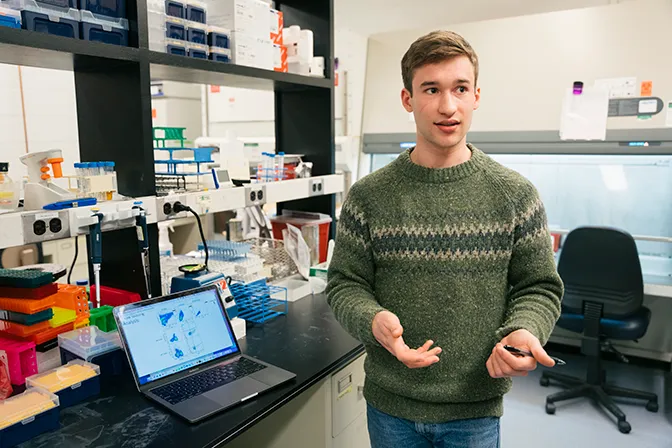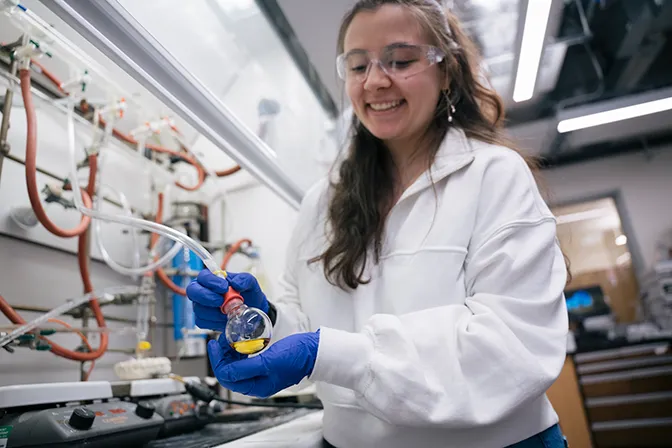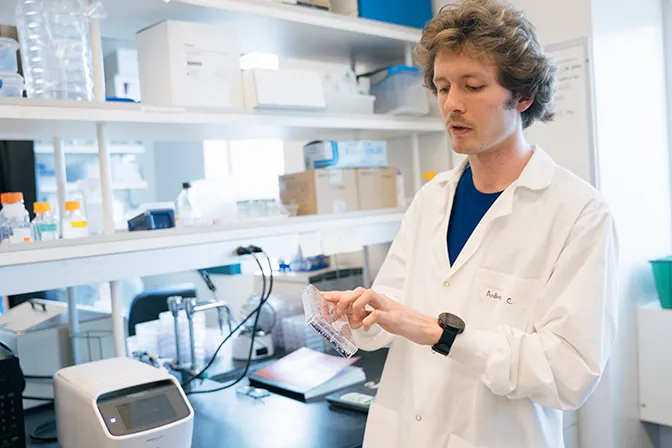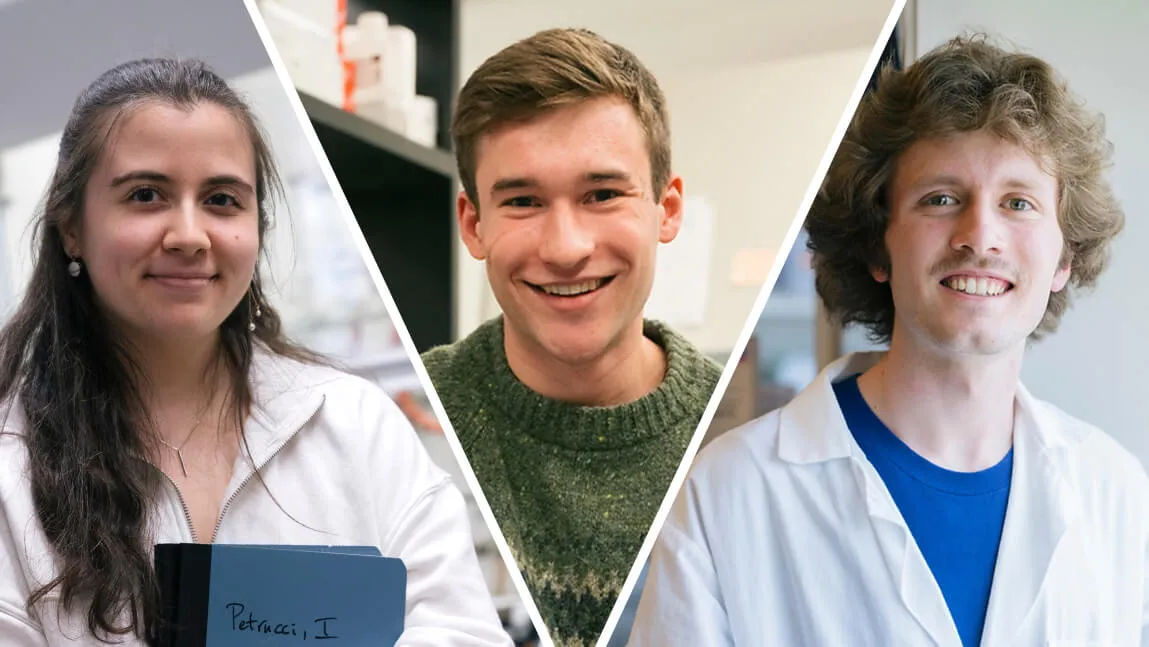On March 25, the University of Vermont was delighted to announce that three students were selected to receive Goldwater Scholarships, the U.S. Congress’s most prestigious undergraduate scholarship in the natural sciences, mathematics, and engineering. A few days later, we dropped in on each of them, as they worked in on-campus laboratories, to get a snapshot of their research—working to better understand the immune system, produce complex molecules that could lead to new medicines, and fight cancer.
Remi Savard: Chasing a mystery of immunity

Remi Savard ’23 looks up from a lab bench to explain that he’s working with Elisa. “Actually, its all-caps, E-L-I-S-A,” he says, holding up a flat plastic tray full of holes. That’s the acronym for a tool with the daunting name “enzyme-linked immunosborbent assay.” He’s using this tool with another daunting-sounding tool called a flow cytometer to see how cells are responding to a complex molecule, cardiolipin, that sometimes goes by the heart-warming name 1,3-bis(sn-3’-phosphatidyl)-sn-glycerol.
And the goal of Savard’s work here in the lab of Professor Jonathan Boyson is rather daunting too: help unpack the biology of how your immune system fights off a flu infection.
“If anyone tells you anything simple about the immune system, they’re wrong,” he says, laughing.
But to simplify things anyway, consider that inside each of your cells, mitochondria are churning away, producing energy. And in the membrane walls of each mitochondrion is a lot of cardiolipin. “When cells die, they poke holes in the mitochondria first,” say Savard, a microbiology and molecular genetics major and member of UVM’s Honors College. And when cells die, that cardiolipin is released into the body.
Savard would like to use this biological fact to, eventually, help in fighting flu and other diseases. When you get the flu, the concentration of cardiolipin in your lungs and blood rises. For his research—supported by the Goldwater Scholarship and UVM’s Office of Fellowships, Opportunities and Undergraduate Research—Savard would like to understand if and how this cardiolipin activates a poorly-understood part of the immune system called innate-like T-cells.
Most T-cells have to learn to fight invaders—whether COVID or flu. That can take several days. But these strange and secretive innate-like T-cells are more like the immune system you’re born with, that “can respond right away,” Savard says. “We know cardiolipin is a signal of cell stress,” he says, like the stress that is caused by flu. The question he wants to answer: which of several families of innate-like T-cells react to the presence of cardiolipin?
There have only been “three or four studies on this,” Savard says, “and they don’t agree. They’re completely at odds with each other.” He’d like to prove that one or more kinds of innate-like T-cells do recognize cardiolipin—opening a new window onto the basic biology of how flu-infected mice in the laboratory react to this virus and other infections. And Savard’s study, in turn, could give medical researchers a new way of understanding human infections and how to help our immune systems in the hyper-complex task of fighting them off.
Isabelle Petrucci: Building blocks for better medicine

Isabelle Petrucci ‘23 is writing a chemical formula on the sliding glass shield of a fume hood in the chemistry lab of professor Matthias Brewer. She’s writing with her right hand. White-coated graduate students in safety glasses pass back and forth but she pays them no mind as she’s explaining to a visiting reporter what an “enantiomer” is and why it’s important. The words, and black lines signifying double-carbon bonds, spread effortlessly over the clear pane. Under the hood, a magnetic spinner, in a round-bottomed glass beaker, goes round and round in a yellow liquid—part of Petrucci’s independent research. She’s building complex molecules to help in the development of new pharmaceutical compounds and medicines.
“When you make compounds, they have a certain 3-D orientation,” explains Petrucci, a chemistry major. “Often there are two forms that are the mirror opposite of each other.” These are enantiomers. Same formula, but very different biological effects. Like the way you have two hands that are the mirror of each other; writing with one works well, a messy disaster with the other. Or imagine trying to read Petrucci’s writing on the glass from the other side.
“It’s very important to be able to control that 3-D orientation for drug development,” she says. “One enantiomer may be very effective biologically, while the other has terrible side effects.”
Her work in Brewer’s lab is looking for ways to create reactions that lead to only one of the enantiomers, “that only have one 3-D orientation in the final product,” she says.
Petrucci’s first class at UVM was organic chemistry with Professor Brewer and she’s been working in this lab for two years, including summers. Among other advances in his field, Brewer has pioneered understanding of a group of compounds with a special kind of double carbon-bond that are of high utility in both industrial and biomedical applications. Petrucci’s work today in the lab aims to control the 3-D orientation of one of these. “I want to control it right here,” she says, pointing to a section of her diagram. “If we find the right catalyst, we can make a kind of pocket where the reaction can occur only in the way we want it.” Then she moves down to the next fume hood. “I have two reactions going in here. I’ve added in the chemicals I’ve wanted and let it stir,” she says. “It’s a matter of percentages, but the purer the compound we get, the better. We’re making progress.” On her way to a research career in the pharmaceutical industry, Isabelle Petrucci is also making rapid progress.
Andrew Crompton: Furthering the search for effective cancer treatments

Andrew Crompton ‘23 did not grow up thinking he would become a cancer researcher. It took a good mentor. “I actually wasn't really interested in biology at all until senior year of high school when I had a great AP biology teacher,” he says, now wearing a lab coat (and stylish mustache) while he examines rows of purple-stained human cancer cells in small plastic trays. And following the path of excellent teaching has led him to a profound interest in the search for cancer treatments—and to this sun-filled lab, on the third floor of Stafford Hall, run by professor Nimrat Chatterjee.
“Dr. Chatterjee is amazing because she carefully explains how everything works in one pathway and allows all the time you need to ask questions—so you understand it,” Crompton says, “But she also gives you freedom to plan experiments in your own way as your own scientist. Having that kind of mentorship is one of the great things about UVM.”
Crompton’s independent research is part of the lab’s larger mission of “reducing or inhibiting cells’ resistance to cancer therapies,” he says. In all cells, DNA repair is critical to survival and reproduction. “Most cancer treatments are just things that will damage DNA—with the hope that they’ll damage it beyond repair and the cancer cells will die,” Crompton says. But cells have a last-ditch method to survive called translesion synthesis.
In more moderate DNA damage, a cell can come in with repair enzymes and fix the broken code. But when the damage is severe enough, the cell “uses these specialized sets of DNA polymerases to come in and not necessarily correct—but just bypass—the damage that normal enzymes can’t get past,” Crompton explains. “So it's a way for cells to keep on replicating their genomes and dividing—at the cost of generating mutations. But the cells stay alive.”
And when the cells are cancerous, that can mean that a disease can overcome or resist treatment. Crompton, working under Dr. Chatterjee’s guidance, is exploring a key protein, called REV1, “that’s basically the scaffolding of this process,” Crompton says. “The focus of my research is exploring: what happens when we inhibit REV1? Do we inhibit translesion synthesis and therefore improve cancer patients’ response to treatments, like chemotherapy?” Andrew Crompton will be hard at work on this question, with support from his mentors, for the rest of his time at UVM—“and the Goldwater Scholarship means a lot for my prospects, my hope to be a research scientist,” he says.
